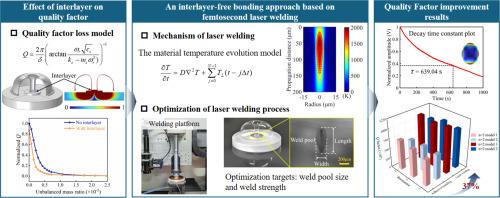激光焊接增强微半球形谐振腔的q因子
IF 9.4
1区 工程技术
Q1 ENGINEERING, MECHANICAL
International Journal of Mechanical Sciences
Pub Date : 2025-09-17
DOI:10.1016/j.ijmecsci.2025.110853
引用次数: 0
摘要
质量因子(q因子)是影响微半球谐振陀螺仪精度和性能的关键指标。目前,阻碍q因子提高的主要因素是锚点损耗,而锚点损耗受微半球谐振腔与衬底间层的影响较大。因此,本文提出了一种创新的基于飞秒激光焊接的无层间键合技术,用于集成谐振腔与衬底。首先,建立锚损模拟模型,分析偏心质量和夹层对q因子的影响机理;分析结果表明,无层间键合显著减轻了偏心质量引起的能量耗散。其次,基于飞秒激光与熔融二氧化硅相互作用机理,建立了材料温度演化模型,揭示了激光参数对熔池形貌的影响;随后,建立了激光焊接平台,并通过单因素实验获得了最优工艺参数。最后,实验结果表明,飞秒激光焊接微半球谐振腔的最大q因子为1177万,比传统的导电胶粘接方法提高了37%。值得注意的是,衰减时间达到了639.04 s,这是迄今为止报道的微半球谐振器最长的衰减时间。研究结果验证了飞秒激光焊接提高q因子的有效性,对制造高性能微半球形谐振陀螺仪具有重要意义。本文章由计算机程序翻译,如有差异,请以英文原文为准。

Q-factor enhancement in micro hemispherical resonators by laser welding
The quality factor (Q-factor) is a pivotal metric for affecting the precision and performance of micro hemispherical resonator gyroscopes. Currently, the primary impediment to enhancing the Q-factor is anchor loss, which is significantly affected by interlayer between the micro hemispherical resonator and substrate. Therefore, this paper proposes an innovative interlayer-free bonding technique based on femtosecond laser welding for integrating resonators with substrates. Firstly, an anchor loss simulation model was established to analyze the influence mechanisms of eccentric mass and interlayers on Q-factor. This analysis reveals that interlayer-free bonding significantly mitigates energy dissipation caused by eccentric mass. Secondly, a material temperature evolution model was constructed based on the interaction mechanism between femtosecond laser and fused silica, which reveals the influence of laser parameters on weld pool morphology. Subsequently, a laser welding platform was established and optimal process parameters were obtained via single-factor experiments. Finally, the experimental results show that the micro hemispherical resonator bonded by femtosecond laser welding achieves a maximum Q-factor of 11.77 million, representing a 37 % improvement compared to the conventional conductive adhesive bonding method. Notably, a decay time of 639.04 s was achieved, marking the longest decay time reported to date for micro hemispherical resonators. This research results validate the effectiveness of femtosecond laser welding in enhancing Q-factor, holding significant implications for manufacturing high-performance micro hemispherical resonator gyroscopes.
求助全文
通过发布文献求助,成功后即可免费获取论文全文。
去求助
来源期刊

International Journal of Mechanical Sciences
工程技术-工程:机械
CiteScore
12.80
自引率
17.80%
发文量
769
审稿时长
19 days
期刊介绍:
The International Journal of Mechanical Sciences (IJMS) serves as a global platform for the publication and dissemination of original research that contributes to a deeper scientific understanding of the fundamental disciplines within mechanical, civil, and material engineering.
The primary focus of IJMS is to showcase innovative and ground-breaking work that utilizes analytical and computational modeling techniques, such as Finite Element Method (FEM), Boundary Element Method (BEM), and mesh-free methods, among others. These modeling methods are applied to diverse fields including rigid-body mechanics (e.g., dynamics, vibration, stability), structural mechanics, metal forming, advanced materials (e.g., metals, composites, cellular, smart) behavior and applications, impact mechanics, strain localization, and other nonlinear effects (e.g., large deflections, plasticity, fracture).
Additionally, IJMS covers the realms of fluid mechanics (both external and internal flows), tribology, thermodynamics, and materials processing. These subjects collectively form the core of the journal's content.
In summary, IJMS provides a prestigious platform for researchers to present their original contributions, shedding light on analytical and computational modeling methods in various areas of mechanical engineering, as well as exploring the behavior and application of advanced materials, fluid mechanics, thermodynamics, and materials processing.
 求助内容:
求助内容: 应助结果提醒方式:
应助结果提醒方式:


